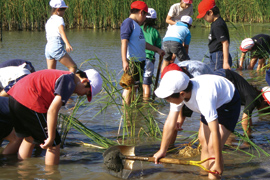The Mitsui & Co. Environment Fund
Introduction to Grant Projects
Asaza Fund
Building a watershed management model with the Asaza regional revitalization project
Activity grant
- Project Description
This organization deploys integrated projects for environmental conservation and regional promotion targetted at the Lake Kasumigaura watershed area as whole, which is experiencing diverse issues. The project is referred to as a "Citizen's public works project" and has to date seen the participation of a total of 160,000 persons from citizens, administrators, schools, and corporations. It endeavors to build new social systems by means of the cooperation of diverse actors.
As part of this project the below specific activities of (1)~(4) are to be conducted.
(1) Deployment of elementary and junior high school environmental education on regional planning centered on the Lake Kasumigaura catchment area
(2) Development of business models towards restoration of the natural environments of the lake by promotion of fisheries and the revitalization of local communities through fish meal projects using non-native fish and cultivation of rape blossoms using uncultivated agricultural land
(3) Promotion of agriculture and local industry through by means of cooperation among residents, corporations, NPOs, etc, restoration of rice paddies in marshy wetlands and development of catchment area marshland conservation model through exchange among towns and farming villages
(4) Deployment throughout Japan by model creation of Azasa Project to tackle above in an integrated manner
- Fields
- Climate changeMarine resources/foodPreservation of surface soil and forestsEnergy problemPreservation of biodiversity and ecosystem
- Grant year
- FY2005 Activity Grants
- Grant term
- 3 years
January 2006 - December 2008
- Grant amount
- 21,671,200 yen
- Activity region
- Lake Kasumigaura catchment area, Ibaraki Prefecture, and throughout Japan

Overview of the Organization

- Representative
- Hiroshi Iijima, Director
- Established
- 1999
- Establishment Purpose
- In the expansive catchment area of Lake Kasumigaura which is experiencing diverse environmental and social issues, it is not possible to solve such issues under top-down initiatives based on past administrative conceptions. In this context, this organization is developing an autonomous and strategic Asaza Project linked to a wide range of fields through a focus on a decentralized network area and centered around children's activities in a wide range of areas. It aims to build community frameworks involving regional environmental conservation and revitalization.
- Main area of activity
- Lake Kasumigaura catchment area and all regions of Japan
- Staff
- 8 full-time staff members, 4 part-time staff members, 44 full members
- Annual operating budget
- 93.51 million yen in 2005, 64.64 million yen in 2006, 85.62 million yen in 2007
- WEB site
- http://www.asaza.jp/
- Recent activities
- The creation of a network using the Asaza Project as a whole-community platform with involvement from fisheries in the catchment area, local industry including agriculture, administration, schools, citizens, corporations and researchers. Conducts regeneration of lakefront vegetation zones, restoration/conservation of marshy valley rice paddies as water resources, conservation of forests as water resources, water purification with eradication of non-native fish and use of fish carcasses as fertilizer to be used in agriculture, and environmental education in over 170 elementary and junior high schools. All such activities are implemented by means of an autonomous network strategy, revealing the region's nature, people and others as latent resources and connecting these resources, to building community frameworks which incorporate regional revitalization and conservation of the functions of the natural environment. In addition, as the regeneration processes by the regional community (school districts) is indispensable for the development of the above, activities are carried out with an emphasis on developing study programs in elementary and junior high schools.